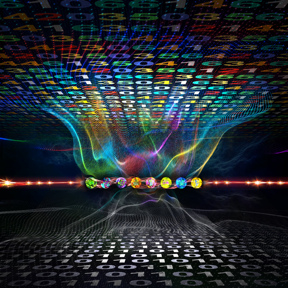Home > Press > Quantum computer works with more than zero and one: Quantum digits unlock more computational power with fewer quantum particles
 |
| The Innsbruck quantum computer stores information in individual trapped calcium atoms, each of which has eight states, of which the scientists have used up to seven for computing.
CREDIT Uni Innsbruck/Harald Ritsch |
Abstract:
We all learn from early on that computers work with zeros and ones, also known as binary information. This approach has been so successful that computers now power everything from coffee machines to self-driving cars and it is hard to imagine a life without them.
Quantum computer works with more than zero and one: Quantum digits unlock more computational power with fewer quantum particles
Innsbruck, Austria | Posted on July 22nd, 2022
Building on this success, todays quantum computers are also designed with binary information processing in mind. The building blocks of quantum computers, however, are more than just zeros and ones, explains Martin Ringbauer, an experimental physicist from Innsbruck, Austria. Restricting them to binary systems prevents these devices from living up to their true potential.
The team led by Thomas Monz at the Department of Experimental Physics at the University of Innsbruck, now succeeded in developing a quantum computer that can perform arbitrary calculations with so-called quantum digits (qudits), thereby unlocking more computational power with fewer quantum particles.
Quantum systems are different
Although storing information in zeros and ones is not the most efficient way of doing calculations, it is the simplest way. Simple often also means reliable and robust to errors and so binary information has become the unchallenged standard for classical computers.
In the quantum world, the situation is quite different. In the Innsbruck quantum computer, for example, information is stored in individual trapped Calcium atoms. Each of these atoms naturally has eight different states, of which typically only two are used to store information. Indeed, almost all existing quantum computers have access to more quantum states than they use for computation.
A natural approach for hardware and software
The physicists from Innsbruck now developed a quantum computer that can make use of the full potential of these atoms, by computing with qudits. Contrary to the classical case, using more states does not make the computer less reliable. Quantum systems naturally have more than just two states and we showed that we can control them all equally well, says Thomas Monz.
On the flipside, many of the tasks that need quantum computers, such as problems in physics, chemistry, or material science, are also naturally expressed in the qudit language. Rewriting them for qubits can often make them too complicated for todays quantum computers. Working with more than zeros and ones is very natural, not only for the quantum computer but also for its applications, allowing us to unlock the true potential of quantum systems, explains Martin Ringbauer.
####
For more information, please click here
Contacts:
Media Contact
Christian Flatz
University of Innsbruck
Office: +43 512 507 32022
Expert Contact
Martin Ringbauer
University of Innsbruck
Office: +43 512 507 52458
Copyright © University of Innsbruck
If you have a comment, please Contact us.
Issuers of news releases, not 7th Wave, Inc. or Nanotechnology Now, are solely responsible for the accuracy of the content.
News and information
![]()
Generating power where seawater and river water meet July 22nd, 2022
![]()
First electric nanomotor made from DNA material: Synthetic rotary motors at the nanoscale perform mechanical work July 22nd, 2022
Possible Futures
![]()
Generating power where seawater and river water meet July 22nd, 2022
![]()
First electric nanomotor made from DNA material: Synthetic rotary motors at the nanoscale perform mechanical work July 22nd, 2022
Chip Technology
![]()
Buckyballs on gold are less exotic than graphene July 22nd, 2022
Quantum Computing
![]()
Optical demonstration of quantum fault-tolerant threshold July 8th, 2022
![]()
University of Illinois Chicago joins Brookhaven Lab’s Quantum Center June 10th, 2022
![]()
Bumps could smooth quantum investigations: Rice University models show unique properties of 2D materials stressed by contoured substrates June 10th, 2022
Discoveries
![]()
HKU physicists found signatures of highly entangled quantum matter July 22nd, 2022
![]()
Buckyballs on gold are less exotic than graphene July 22nd, 2022
Announcements
![]()
Generating power where seawater and river water meet July 22nd, 2022
![]()
First electric nanomotor made from DNA material: Synthetic rotary motors at the nanoscale perform mechanical work July 22nd, 2022
![]()
Lithiophilic seeds and rigid arrays synergistic induced dendrite-free and stable Li anode towards long-life lithium-oxygen batteries July 22nd, 2022
Interviews/Book Reviews/Essays/Reports/Podcasts/Journals/White papers/Posters
![]()
Buckyballs on gold are less exotic than graphene July 22nd, 2022
![]()
Generating power where seawater and river water meet July 22nd, 2022
![]()
First electric nanomotor made from DNA material: Synthetic rotary motors at the nanoscale perform mechanical work July 22nd, 2022










